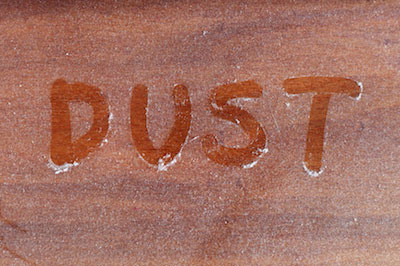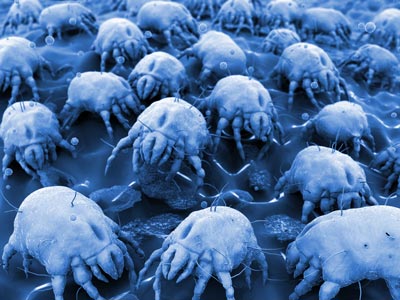House dust is the major cause of year-round runny or stuffy nose, itchy, watery eyes, and sneezing for allergy sufferers. Dust can also make people with asthma suffer attacks or wheezing, coughing and shortness of breath.
 Why does house dust cause allergic reactions?
Why does house dust cause allergic reactions?
House dust is a mixture of many kinds of waste materials. Its content varies from home to home, depending on the type of furniture, building materials used, presence of pets and other factors. A speck of dust may contain fabric fibers, human skin particles, animal dander, microscopic creatures called mites, bacteria, parts of cockroaches. mold spores, food particles and other debris. A person may be allergic to one or more of these substances, and, if exposed to the dust, will have an allergic reaction.
 Is dust allergy a sign of a dirty house?
Is dust allergy a sign of a dirty house?
No, a dirty house can make a house-dust allergy problem worse, but in all likelihood, normal housekeeping procedures may not be enough to relieve house-dust allergy symptoms. Tiny creatures called house dust mites seem to be the major allergen (cause of allergic reactions) in house dust. A recent study in England showed that 10 percent of the general population and 90 percent of people with allergic asthma have positive skin tests for allergy to dust mites. Recent studies in the U.S. suggest that at least 45 percent of young people with asthma are allergic to dust mites.
People allergic to dust mites react to proteins in the bodies and digestive waste (feces) of the mites. These waste particles are so tiny and light that they float easily into the air when anyone walks on the carpet or disturbs bedding. When allergic people inhale these particles. they suffer symptoms.
No matter how vigorously you dust or vacuum. you will not reduce the number of dust mites present deep within carpeting and mattresses. In fact, usual cleaning methods actually put more dust into the air, making symptoms worse.
What are dust mites?
Dust mites belong to the family of 8-legged creatures called Arachnids. This family also includes spiders. chiggers and ticks. Dust mites - which can only be seen with a microscope - are hardy creatures that live well and multiply easily in warm, humid places. They prefer temperatures at or above 70°F. with relative humidity at 75-80 percent. Mites die when the humidity falls below 40-50 percent and are rarely found in very dry climates.
As many as 18,875 dust mites can live in one gram of dust, but the usual population is about 100 to 500 mites per gram. (A gram is about the weight of a paper clip). Each mite produces about 10-20 waste particles each day and lives for 30 days. Egg-laying females can add 25-30 new mites to the population.
Mites eat particles of skin and dander and thrive in bedding. carpeting, upholstered furniture, clothing. closets and automobile seats – all likely to contain skin particles. Dust mites don't bite, cannot spread diseases and never live on people, only in the environment. They are harmful only to people who become allergic to them. While usual household insecticides have no effect on dust mites, a new product (described later) is now available to kill mites and help remove them from carpeting.
Are house dust allergies seasonal?
In the U.S., mite populations appear to peak in July and August, and allergen levels stay high through December. Allergen levels are lowest in April and May. Although dust mite populations decrease during winter in areas where the climate is cold and dry, some sensitive people report that their symptoms get worse at that time! That's because mite fecal particles and pieces of dead mites, both of which trigger dust mite allergy, are still present. Forced-air heating systems blow these panicles up into the air, and, as dust dries out over time, even more of the particles become airborne. People may get fewer symptoms in the summer because they spend more time outdoors and need not run the furnace indoors.
How do I know if I have dust mite allergy?
If you think you may have an allergy to house dust mites, consult an allergist. To pinpoint the cause of your symptoms, the allergist may ask questions about your work and home environments, eating habits, family medical history, frequency and severity of symptoms, exposure to pets and a variety of other questions. Your allergist may employ skin testing, observing your body's reaction to various possible allergens placed under the skin. A positive reaction (a raised welt with redness around it) shows that you are allergic to that allergen. Skin testing is the easiest, most sensitive and least expensive way to identify an allergy. In some cases, however, skin lest results may be unclear and your allergist may require a RAST test – analysis of a small blood sample – to confirm the diagnosis.
What can I do to relieve dust mite allergy symptoms?
The three basic treatments for dust mite allergy are:
- Dust mite avoidance
- Prescription medication
- Allergy shots
Dust mite avoidance works best to relieve symptoms.
How do I avoid dust mites?
Dust mites are difficult to remove completely from your home. However, you can follow certain anti-mite procedures that will reduce mite populations and your exposure to them, thereby reducing your symptoms. Some of these procedures are expensive, and you may not need to do them all. Ask your allergist which ones will be most helpful for your situation.
Reduce Surface Dust
- Clean your home thoroughly, on a regular basis. Vacuum frequently and dust with a damp or oiled cloth. Ideally, someone other than the dust-sensitive person should clean, but if this is impossible, wear a dust mask.
- Get rid of carpeting, especially in the bedroom. Carpeting is a breeding ground for dust mites. If you must have carpeting, select a type with low pile. Scatter rugs that can be washed each week are a better alternative, Wood floors, seamless vinyl or linoleum floor coverings are best because they can be cleaned easily and thoroughly, and mites don't like to live on uncarpeted floors.
- Remove from your home any items that tend to collect or hold dust and replace them with easy-to-clean items. Use wooden, leather or plastic-covered sofas and chairs instead of upholstered furniture (particularly older furniture stuffed with cotton, kapok, feathers and down, or animal hairs). Select closed bookcases and curio cabinets instead of open shelves. Books and knickknacks are dust collectors. Use washable curtains or window shades instead of venetian blinds and heavy draperies. Choose furniture with simple, clean designs instead of ornately carved pieces. Select easily cleaned decorations instead of dried-flower arrangements, wall hangings and straw baskets.
Reduce Dust in the Air
Use air conditioning to keep inside humidity at 50 percent or lower to slow down mite growth during warm weather months. A sling hygrometer or wet-dry thermometer may help monitor humidity
Change or clean air conditioner and furnace filters often. Consider using an HEPA (high energy particulate air) air cleaner on your heating system.
Pay Special Attention to Bedrooms
On average, people spend one-third of their lives in the bedroom, and studies have shown that, of all the rooms in the home, the bedroom often contains the most dust mites. Concentrate efforts in the bedroom of the dust-sensitive person, following all the steps above, plus:
- Install a room air conditioner and dehumidifier in the bedroom if the home does not have central air conditioning
- Place a filter made of cheesecloth under the faceplate of the bedroom heating vent to help prevent recirculating of dust into the bedroom air
- Select nonallergic, washable bedding materials. Rather than pillows stuffed with feathers, down, kapok or foam rubber, use pillows stuffed with dacron or other synthetic materials. Nonallergic plastic casings that zip around mattresses, box: springs and pillows will help keep mites under control. Cover the zippers of these casings with adhesive tape to make a better barrier. Avoid comforters and chenille bedspreads.
- Use washable blankets and spreads, and wash all bedding (including pillows without cases) every week to 10 days, using hot water.
- Hang clothes in a closet and keep the closet door closed, or put them into dresser drawers.
- Get rid of stuffed animals; they collect dust mites.
- Never allow pets in the bedroom.
What products are available to get rid of dust mites?
Many people may not want to get rid of carpeting to avoid dust mites, but until recently. there were no other alternatives. New products, available today, remove dust mites or their allergen from carpet fibers. One product, tannic acid, breaks down mite allergen but does not kill the mites. Another product, benzyl benzoate dry foam, actually kills mites and helps remove them and their waste products from carpet.
Tannic acid can be sprayed on carpets or upholstered furniture to break down allergen from mites or cat dander. When the allergen is inactivated, it can no longer cause allergy symptoms. Tannic acid works fast and is easy to use, but its effects do not last long because mites remain and allergen continues to build up. requiring frequent application of the product, Also, some people have complained it may stain some carpets and upholstery fabrics.
To kill mites, benzyl benzoate moist powder can be brushed into carpets, allowed to dry for 8 to 12 hours, and vacuumed up. The Environmental Protection Agency (EPA) has approved this product as safe for home use, and it will not usually stain carpets. Unlike tannic acid, benzyl benzoate's effect is long-lasting. After one or two initial applications. you can keep mites and your symptoms under control by using it only once or twice a year.
What if avoiding dust mites doesn't work for me?
If you follow these procedures to reduce your exposure to dust mites but allergy symptoms persist, your alIergist may recommend other treatment methods, such as medication or allergy shot treatments. Consult your allergist to determine the most effective treatment method for you, and you can gain control of your dust mite allergy and achieve relief from allergy symptoms.
